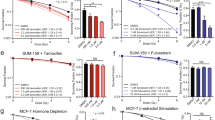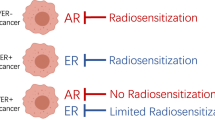Abstract
Strategies for diagnosis and therapy in which sex steroid receptor ligands serve as carriers for radionuclides are attractive because a high incidence of carcinomas of the female genital tract and the breast that are seen clinically have an abundant expression of one or more of the receptor proteins. A radiohalogenated estrogen receptor (ER) ligand, 16α-[123I]iodo-17β-estradiol [123I]E, has met clinical criteria for receptor-mediated diagnostic imaging. Its [125]I-labeled sister nuclide derivative [125I]E decays by orbital electron capture with emission of very-low-energy (Auger) electrons, which gives this latter radiohalogen the potential to serve in pharmaceuticals for radiotherapy; as examples, [125I]deoxyuridine, when incorporated into the DNA molecule, or [125I]E, when bound to the receptor within ER-rich tumor cells, are both cytotoxic in vitro. Whereas the mechanisms and subcellular changes that accompany the cytotoxicity from [125I]deoxyuridine are well documented in the form of aberrations and breaks in the cellular DNA, the effects at the subcellular level causing the cytotoxicity of the sex steroid receptor ligand [125I]E have not been characterized and are the focus of our study. We found that in a standard colonyforming assay the addition of [125I]E to the cultures decreased the survival rate of ER-positive MCF-7 cells in a dose-dependent manner. The decreased survival rate was prevented by the addition of competing excess radioinert ER ligand (diethylstilbestrol); [125I]E did not reduce survival in ER-negative MCF-7 cells. The [125I]E-induced and ER-mediated cytotoxicity was accompanied by aberrations in the DNA components of the nuclei of the cells. These included chromatid and chromosome breaks, gaps, and tri-radial chromosome formation. Our findings add plausibility and credence to the notion that the cytotoxicity imparted by Auger-electron-emitting radioligands for sex steroid receptors is in part attributable to radiodecay that causes double-stranded breakage of DNA.
Similar content being viewed by others
Abbreviations
- [125I]E:
-
16α-[125I]iodo-17β-estradiol
- [123I]E:
-
16α-[123I]iodo-17β-estradiol
- ER:
-
estrogen receptor
- DES:
-
diethylstilbestrol
References
Adelstein SJ, Kassis AI (1987) Radiobiologic implications of the microscopic distribution of energy from radionuclides. Nucl Med Biol 3:165–169
Allegra JC, Lippman ME, Thompson EB, Simon R, Barlock A, Green L Huff KK, Do HMT, Aitken SC (1979) Distribution, frequency, and quantitative analysis of estrogen, progesterone, androgen, and glucocorticoid receptors in human breast cancer. Cancer Res 39:1447–1454
Anderson RE, Holt JA (1989) Binding of radiolabeled estrogens by human cells in vitro: implications to the development of a new diagnostic and therapeutic modality in the treatment of malignancies with estrogen receptors. Gynecol Oncol 34:80–83
Baranowska-Kortylewicz J, Makrigiorgos GM, Van den Abbeele AD, Berman RM, Adelstein SJ (1991) 5-[124I]iodo-2′-deoxyuridine in the radiotherapy of an early ascites tumor model. Int J Radiat Oncol Biol Phys 21:1541–1554
Bindal RD, Carlson KE, Katzenellenbogen BS, Katzenellenbogen JA (1988) Lipophylic impurities, not phenolsulfonphthalein, account for the estrogenic activity in commercial preparations of phenol red. J Steroid Biochem 31:287–293
Bloomer WD, McLaughlin WH, Milius RA, Weichselbaum, RR, Adelstein SJ (1983) Estrogen receptor-mediated cytotoxicity using iodine-125. J. Cell Biochem 21:39–45
Bonzert DA, Hochberg RD, Lippman ME (1982) Specific cytotoxicity of 16α-[125I]iodo-estradiol for estrogen receptor-containing breast cancer cells. Endocrinology 110:2177–2179
Bradley EW, Chan PC, Adelstein SJ (1975) The radiotoxicity of iodine-125 in mammalian cells: 1. Effects on the survival curve of radioiodine incorporated into DNA. Radiat Res 64:555–563
Chan PC, Lisco E, Lisco H, Adelstein SJ (1976). The radiotoxicity of iodine-125 in mammalian cells: II. A comparative study on cell survival and cytogenetic response to 125IUdR, 131IUdR, and 3HTdR. Radiat Res 67:332–343
Cordell JR, Falini B, Erger W, Ghosh A, Abdulaziz Z, MacDonald S, Pulford K, Stein H, Mason D (1984) Immunoenzymatic labeling of monoclonal antibodies using immune complexes of alkaline phosphatase and monoclonal anti-alkaline phosphatase (APAAP complexes). J Histochem Cytochem 32:219–229
DeSombre ER, Harper PV, Hughes A, Mease RC, Gatley SJ, DeJesus OT, Schwartz JL (1989) Bromine-80m radiotoxicity and the potential for estrogen receptor-directed therapy with auger electrons. Cancer Res 48:5805–5809
Evans RM (1988) The steroid and the thyroid hormone receptor superfamily. Science 240:889–895
Fiet J, Boudou P, Burthier JM, Villette JM (1991) Application of scintillation proximity assay to homogeneous radioimmunoassay of androstendione, dihydroandrosterone, and 11 beta-hydroxyandrostendione. Clin Chem 37:293–297
Holt JA, Artwohl JA, Mercer LJ, Pryde PG (1991) Biodistribution, with high uptake by the reproductive tract, of an intraperitoneally infused radiohalogenated steroidal estrogen-receptor ligand. Int J Radiat Oncol Biol Phys 20:567–573
Kassis AI, Adelstein SJ, Haycock C, Sastry KSR, McElvany K, Welch MJ (1982) Lethality of Auger electrons from the decay of bromine-77 in the DNA of mammalian cells. Radiat Res 90:362–373
Kassis AI, Sastry KSR, Adelstein SJ (1987) Kinetics of uptake, retention, and radiotoxicity of I-125 IUdR in mammalian cells: implication of localized energy deposition by Auger processes. Radiat Res 109:78–89
Lorincz MA, Holt JA, Greene GL (1985) Monoclonal antibody recognition of multiple forms of estrogen receptor tagged with [125I]methoxy-iodovinyl estradiol in ovarian carcinomas. J Clin Endocrinol Metab 61:412–417
Lowry OH, Rosebrough NJ, Farr L, Randall RJ (1951) Protein measurement with the folin phenol reagent. J Biol Chem 193:265–275
Martin RF, Haseltine WA (1981) Range of radiochemical damage to DNA with decay of iodine-125. Science 213:896–899
Martin AO, Simpson JL, Rosinsky BJ, Elias S (1986) Chorionic villus sampling in continuing pregnancies: 2. Cytogenetic reliability. Am J Obstet Gynecol 154:1353–1362
McGuire AH, Dehdashti F, Siegel BA, Lyss AP, Brodack JW, Mathias CJ, Mintun MA, Katzenellenbogen JA, Welch MJ (1991) Positron tomographic assessment of 16α-[17F]fluoro-17beta-estradiol up-take in metastatic breast carcinoma. J Nucl Med 32:1526–1532
McLaughlin WH, Milius RA, Pillai KMR, Edasery JP, Blumenthal RD, Bloomer WD (1989) Cytotoxicity of receptor-mediated 16α-[125I]iodo-estradiol in cultured MCF-7 human breast cancer cells. J Natl Cancer Inst 81:437–440
McManaway ME, Jagoda EM, Kasid A, Eckelman WC, Francis BE, Larson SM, Gibson RE, Reba RC, Lippman ME (1987) [125I]17-alodovinyl 11b-methoxyestradiol interaction in vivo with estrogen receptors in hormone-independent MCF-7 human breast cancer transfected with the v-ras oncogene. Cancer Res 47:2945–2949
Patterson MK (1979) Measurement of growth and viability in culture. Methods Enzymol 58:141–149
Rao DV, Narra VR, Howell RW, Govelitz GF, Sastry KSR (1989) In-vivo radiotoxicity of DNA-incorporated125I compared with that of densely ionizing alpha-particles. Lancet 2:650–653
Scharl A, Beckmann MW, Artwohl JA, Kullander S, Holt JA (1991) Rapid liver metabolism, urinary and biliary excretion, and enterohepatic circulation of 16alpha-radioiodo-17beta-estradiol. Int J Radiat Oncol Biol Phys 21:1235–1240
Scheidhauer K, Müller S, Smolarz K, Bräutigam P, Briele B (1991) Tumor-Szintigraphie mit123J-markiertem Östradiol beim Mammakarzinoma-Rezeptorszintigraphie. Nucl Med 30:84–99
Schober O, Scheidhauer K, Jackisch C, Schicha H, Smolarz K, Bolte A, Reiners C, Höffken K, Biersack HJ Briele B, Moser E, Bräutigam P (1990) Breast cancer imaging with radioiodinated oestradiol. Lancet 335:1522–1523
Seevers RH Jr (1987) Steroid receptor binding radiopharmaceuticals as potential therapeutic agents. In: Spencer RP, Seevers RH Jr, Friedman AM (eds) Radionuclides in therapy. CRC, Boca Raton, pp 145–166
Soule HD, Vazquez J, Long GJ (1973) A human cell line from a pleural effusion derived from breast carcinoma. J Natl Cancer Inst 51:1409–1416
Standing Commitee on Human Cytogenetic Nomenclature (1978) The international system for human cytogenetic nomenclature (1978) ISCN (1978). Cytogenet Cell Genet 21:371–374
Swinkels LMJW, Ross HA, Benraad TJ (1991) Scintillation proximity assay: determination of steroid hormones without separation of antibody-bound and free ligand. Ann Clin Biochem 28:87–90
Taylor CM, Blanchard B, Zava DT (1984) A simple method to determine whole cell uptake of radiolabelled oestrogen and progesterone and their subcellular localization in breast cancer cell lines in monolayer culture. J Steroid Biochem 5:1083–1088
Toft DO, Wahner HW (1982) Radiochemical probes for steroid hormone receptors. J Nucl Med 23:451–453
Udenfriend S, Dieckmann GL, Brink L, Spector S (1985) Scintillation proximity radioimmunoassay utilizing 125I-labeled ligands. Proc Natl Acad Sci USA 82:8672–8676
Vessieres A, Vaillant C, Top S, Osella D, Jaouen G (1990) Polynuclear complexes of estradiol substituted at the 17alpha-position. A new family of affinity markers. J Steroid Biochem 36:52S
Woo DV, Li D, Mattis JA, Steplewski Z (1989) Selective chromosomal damage and cytotoxicity of a 125I-labeled monoclonal antibody 17-1a in human cancer cells. Cancer Res 49:2952–2958
Author information
Authors and Affiliations
Rights and permissions
About this article
Cite this article
Beckmann, M.W., Scharl, A., Rosinsky, B.J. et al. Breaks in DNA accompany estrogen-receptor-mediated cytotoxicity from 16α[125I]iodo-17β-estradiol. J Cancer Res Clin Oncol 119, 207–214 (1993). https://doi.org/10.1007/BF01624432
Received:
Accepted:
Issue Date:
DOI: https://doi.org/10.1007/BF01624432




